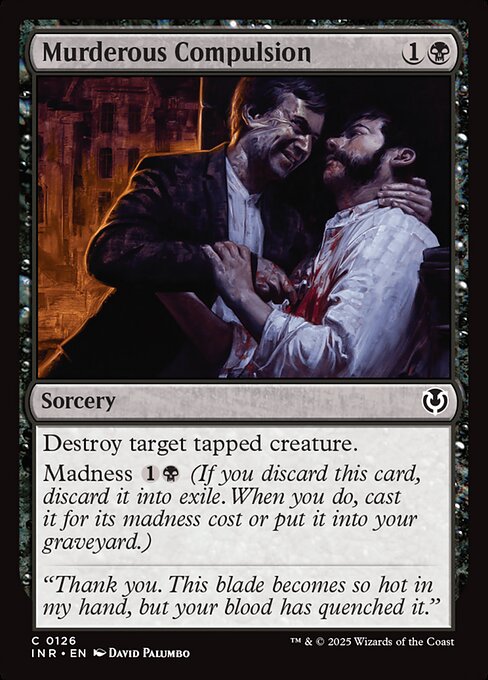
Image courtesy of Scryfall.com
Power Scaling Across MTG Sets: A Deep Dive with Murderous Compulsion
Two mana for a black sorcery that destroys a tapped creature might sound modest at first glance, but when you trace its journey through different sets and formats, Murderous Compulsion reveals how a single card can scale in usefulness, flavor, and strategy across time 🧙🔥💎⚔️. Hailing from Innistrad Remastered (INR), a reprint that folds classic horror into modern accessibility, this spell becomes a microcosm for how power curves shift from draft tables to eternal formats. The art by David Palumbo—grim, heated, and cinephile-gothic—reminds us that even a common card can carry a signature moment in the Multiverse 🎨.
Card snapshot: what you’re actually getting
- Mana cost: {1}{B}
- Type: Sorcery
- Rarity: Common
- Text: Destroy target tapped creature. Madness {1}{B} (If you discard this card, exile it. When you do, cast it for its madness cost or put it into your graveyard.)
- Set: Innistrad Remastered (INR) — a masters-set reprint that bridges classic Innistrad flavors with modern printing standards
- Oracles and mechanics: A straightforward removal spell with the twist of Madness, which invites discard-based synergy and timing tricks
- Artist: David Palumbo
- Legalities: Modern, Legacy, Vintage, Commander legal (with the usual caveats that it isn’t Standard-formatted in today’s standard rotation)
What makes Murderous Compulsion interesting isn’t just the instant relief of removing a tapped attacker. It’s the way the Madness ability lets you convert a potential discard into extra value. When the card sits in your hand, it’s a clean, efficient removal spell for two mana. When you discard it—and many black decks have cheap discard outlets—that same spell can return to the battlefield for its Madness cost, or you can exile it and pivot toward graveyard-based plans. That dual path is the core of its power scaling: a modest rate in one mode becomes a springboard for broader strategies in another 🧙♂️🎲.
Madness and power scaling across formats
Madness is the keystone that helps Murderous Compulsion evolve from a simple curb-stomper in limited to a versatile tool in constructed formats. In Limited, you want to maximize every two-mana play. A destroyed tapped creature can swing tempo in your favor, and the Madness option gives you a late-game engine if you’ve stacked discard effects or throwaway spells. In higher-power formats like Modern or Commander, the same card shines in different ways:
- Modern: You’ll rarely want to rely on a basic two-mana destruction spell as your primary game plan, but Murderous Compulsion can slot into black midrange or control shells that lean on efficient removal and graveyard synergy. Its Madness cost provides an avenue to leverage discard outlets, giving you a tempo swing when you push discard triggers or reanimate from the graveyard later in the game.
- Pioneer and Legacy: Similar to Modern, the card’s speed and reliability offer a flexible answer to early boards, especially when paired with discard engines and recursion strategies. The Madness line is the real amplifier here—casting it from exile after discarding can feel like you’ve drawn two cards in one turn, depending on your deck plan.
- Commander: In EDH, removal on a 2-mana cheap spell is priceless, and Madness can fuel archetypes that lean into graveyard value, sacrifice mechanics, or heavy-card-draw control shells. The card’s color identity (black) and its common status mean you might find it in a bargain-bin staple slot that supports flexible, board-advantage plays across games.
In the grand tapestry of MTG’s power scaling, a card like Murderous Compulsion demonstrates a crucial design truth: power isn’t only about raw removal. It’s about the timing, the pitch-black suspense of a Madness moment, and how a card’s power profile evolves when you pull it from your hand, exile it, or cast it again from the graveyard. The card’s inherent risk-reward ratio—destroy a tapped creature now, or set up a Madness re-entry later—embodies the kind of elegant ambiguity that fans adore in Innistrad’s gothic flavor 🧙♀️⚔️.
Flavor, cost, and the cultural echo
The flavor text, “Thank you. This blade becomes so hot in my hand, but your blood has quenched it,” captures a recurring Innistrad motif: power that bites back just when you think you’re safe. The red-hot blade imagery dovetails with the set’s horror-and-feud atmosphere, where bargains with fate are ritualized in shadow and steel. Palumbo’s artwork pairs with the text to create a compact narrative: a tool that promises decisive action but also invites a grim bargain with fate—the sort of moral tightrope that has kept Innistrad within MTG’s cultural imagination for years 🎨.
From a collector’s lens, the card’s common rarity keeps it approachable, but its foil variant and reprint history in INR add a layer of collectability. The market prices in the data—roughly a few cents for nonfoil and a touch more for foil—reflect a broader trend: hundreds of common cards remain the backbone of sealed pool strategies and budget decks, while still offering a touch of nostalgia for long-time players who remember when the Madness mechanic first roamed the Multiverse 🧩. And with the Innistrad Remastered print, you get a taste of the classic art direction with modern print quality, a sweet spot for both nostalgia and playability.
In the grand, looping universe of MTG, Murderous Compulsion is a small but telling signal of how a card’s power interacts with format, deck building, and the player’s mindset. It’s the kind of spell that invites a player to think three steps ahead: do I need removal right now, or can I leverage a discard outlet to blossom a late-game board presence? It’s about tempo, debt, and leverage—three things that have always driven MTG’s most memorable turnarounds 🧙♂️💎.